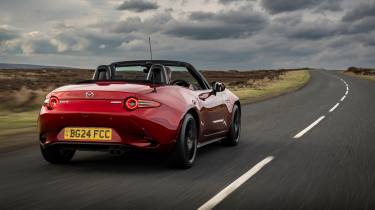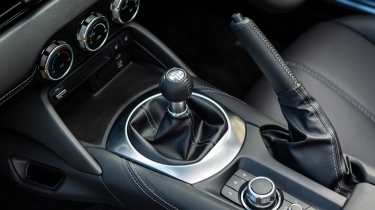Mazda MX-5 review - Engines, drive & performance
“Its low weight means the new MX-5 doesn’t need loads of horsepower to offer a fun and involving driving experience”
While the Mazda MX-5 may have become a lot more modern and polished over the years, the latest model still sticks to the fundamentals that made the original Mk1 MX-5 so good when it was released. It is rear-wheel drive and front-engined like that car, and its small proportions and light weight make it just as agile and enthusiastic as the original.
As a result, the latest Mazda MX-5 feels superb to drive, with responsive well-weighted steering. Cars get a limited-slip differential as standard with the 2.0-litre engine, which helps keep traction consistent at the rear wheels to push the MX-5 through the corners. Mazda also adds Bilstein dampers for the suspension, for a marked improvement over the 1.5-litre models’ softer setup, giving a more purposeful driving feel without being horrendously uncomfortable.
The standard 1.5-litre MX-5 has quite soft suspension for a sports car, which means there's some body lean that can take a while to get used to, although this does allow the driver to better feel the car's weight transfer as they drive, and pushes the tyres into the tarmac to improve grip.
While canvas-top convertibles will always suffer to some degree in terms of refinement, the latest MX-5 is much better in this regard and wind noise isn’t as insufferable when compared to that of the last-generation car. For even better insulation from road and wind noise, the Mazda MX-5 RF will be a much better bet, though it is 40kg heavier than the soft-top version and therefore marginally slower.
More reviews
The six-speed manual gearbox is a joy to use, with slick gear changes and a nice solid feel to it. The small, stubby gearstick is easy to operate and we’d go as far as to say that it’s right up there with some of the greatest manual transmissions, only bettered by cars like the Honda Civic Type R and Porsche 911.
Our only minor gripe with the MX-5 was that the driving position could feel a little tight for anyone over average height, and the pedal position could take some getting used to – the accelerator pedal feels closer to the driver than the clutch or brake pedals do.
Mazda MX-5 petrol engines
Mazda has really strived to appeal to purists with the MX-5 this time around, and despite more widespread implementation of turbocharging across the industry in the last decade or so, Mazda has resisted the urge, offering a choice of a naturally aspirated 1.5-litre or 2.0-litre SKYACTIV petrol engines.
Keeping the engines naturally aspirated rather than turbocharged means the power delivery is a lot more consistent and linear, rather than the surge of power usually attributed to a turbo engine. In 1.5-litre guise particularly, the MX-5 is truer to its origins with around 130bhp – just about 15bhp more than the 1.6-litre Mk1 – and it takes care of the 0-62mph sprint in 8.3 seconds. It feels quicker than its on-paper figure in the real world, and revs quickly with an enthusiastic bark from the exhaust.
While many will be happy enough with that engine, we prefer the 2.0-litre version. The 181bhp it delivers makes it even more thrilling without reaching obnoxious levels, and the improved suspension and limited-slip differential that are thrown in when you go for the larger engine make it feel even more capable. Mazda made some revisions to the MX-5’s engine to improve throttle response making it feel more eager, and the engine sound was improved, too, so it feels more visceral than ever. This model will get from 0-62mph in 6.5 seconds.
RF models have slightly longer acceleration times because they’re a bit heavier. The 1.5 takes 8.7 seconds and the 2.0-litre takes 6.8 seconds.












